GNGE Alliance ECML Capacity Relief ProjectConstruction Only Award |
|
Project Team
Client: Network Rail
Designer: GNGE Alliance
Contractor: GNGE Alliance
-------------------------------------------------------------------------------------------------------------------------------------------------------------------------------------
Project summary
The overall scope for the GNGE Alliance East Coast Mainline Capacity Relief Project was to increase capacity for freight and passenger trains on the Great Northern/Great Eastern (GNGE) Line. The Project (circa £280 million) was a phased programme of
renewals led by the GNGE Alliance and Network Rail and delivered in an alliancing partnership with Carillion, Babcock’s and
Siemens. Additional sub-contracts were provided by Balfour Beatty and Kier, reporting directly to Network Rail.
The 86-mile GNGE Line runs from Werrington (just north of Peterborough) through Spalding, Sleaford, Lincoln and Gainsborough, reconnecting with the East Coast Main Line at Doncaster. The vast majority of the route is rural in nature but does travel through a number of towns and villages. Therefore the potential to impact local stakeholders was not underestimated.
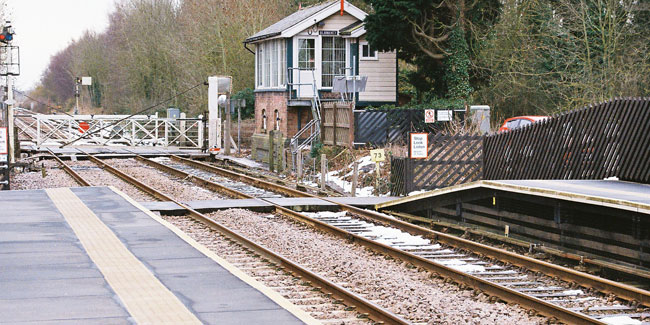
The works included the following:
- Level crossings – The largest ever level crossings programme of its type on the national rail network, with all of the GNGE route’s 147 level crossings individually risk assessed to determine specific requirements, leading to the renewal/enhancement of 61 level crossings along the line of route. We also closed three crossings at Fox Covert, Saxilby and Metheringham Stations.
- Signalling – Installation of a new modular signalling system along the whole route, with the decommissioning of 13 signal boxes.
- Track – Replacing over 74,000 yards of jointed track, sleepers and ballast with continuously welded rail and track bed. This will improve ride quality, reduce maintenance and provide improved management of noise and vibration.
- Bridgeworks – Renewal/enhancement of 31 underbridge, and renewal/enhancement of 26 overbridges.
- Tunnel works at Branston – Washingborough;
- Additional infrastructure works including lineside fencing, platform gauging, embankment stabilisation and culverts.
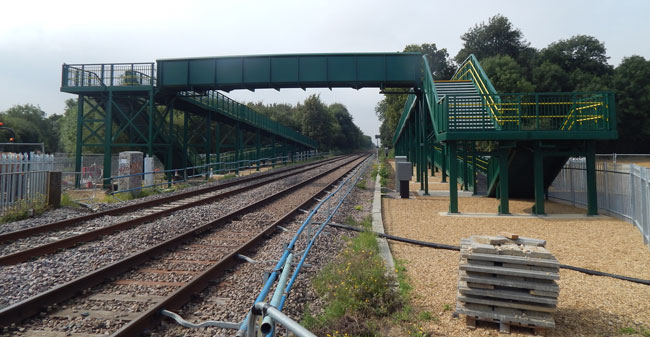
As you can see from the above scope of works this was a massive multi-disciplined civil engineering project that also placed a major emphasis on the environment and consideration of local communities affected by the works. To this end in January 2013, the project committed to attaining (through its Key Result Area Targets for Environment & Sustainability) a CEEQUAL Score of Good (with a Stretch Target of Very Good) and an additional 13 Environment and Sustainable Targets and Objectives.
Challenges faced and Achievements
The GNGE Alliance Environment Manager and Alliance Leadership Team set 14 stringent Environmental and Sustainable Targets and Objectives for the Project. Every 4 weeks these Targets and Objectives were reviewed, tracked and trended. Of the 14 GNGE Alliance Environmental Targets and Objectives set, 12 were achieved and 4 exceeded their Stretch Targets. In addition the Environmental Management Team also identified and implemented a number of innovative and project unique initiatives, some of which are outlined below:Physical Resources - Use and Management
The project target was to recycle or divert from landfill over 95% of waste produced and to reduce the amount of construction and demolition waste going off-site, with an aim to recycle on site at least 10% (with a stretch target of 25%). The Project’s average Waste Recycling figure was 97.9% and we recycled over 20,000 tonnes (19%) of our wastes in situ.
Biodiversity Enhancement and Community Legacy Projects
The GNGE Alliance set a target to implement at least 4 sustainable and biodiversity enhancement projects across the linear length of the Project. Through discussions with the local communities we identified sites at some of the villages most affected by our work programme to put something back into these communities to offset any inconvenience resulting from our works. The Alliance actually implemented 6 including:
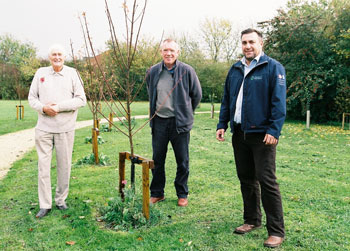 |
|
|
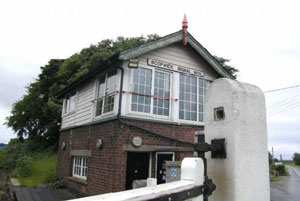 |
Assessing the Project’s Carbon Footprint and minimising Fossil Fuel Consumption
The Alliance set a Carbon Footprint Baseline of 0.6 tonnes CO2 for each person working on the GNGE Project (this figure included embedded carbon from the construction materials, average commuting and any devegetation carried out by the Project). Performance against this Target was monitored every period and if the project exceeded 0.6 tonnes per person, the amount of Carbon exceeded was offset by the planting of trees on and off-site. To this end the Project planted an additional 1782 trees and hedgerows and seeded (using wildflower seed mixes wherever possible) over 23,000m2 along the Project Corridor. Furthermore through installing Passive Infrared (PIR’s) Sensors in the main Project Offices we saw a 13% reduction in energy consumption in the intervening period and nearly £1000 saved in the 6 months post installation (resulting in a likely payback of 2.5-3 years). |
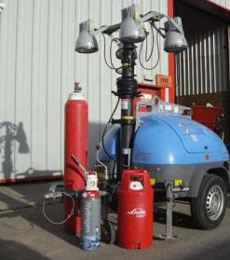 |
Further innovations to reduce fossil fuel use were the use of Hydrogen Fuel Cell Lighting Rigs and the use of the Mission Room to save vehicle journeys to site. The Mission Room is a Three Dimensional Room that allows users to stand within this room to view high definition film recorded from trains travelling along the GNGE Line. This captures all Level Crossings, Bridges, Access Points, etc along the whole 86 mile length of the route, and thus helped to reduce significantly the number of visits and journeys made to site. We have calculated that over 5,000 miles of travel were avoided by using the Mission Room.
Innovative Environmental Management Techniques
- Environmental Surveys and Consent attainment – The Alliance set a target to ensure that all environmental surveys and consents were attained prior to works commencing. This was one of the most innovative and vitally useful tools developed on the GNGE Alliance. On many other Rail Projects, the gaining of environmental surveys and consents can be stressful and although it can be aligned to the project programme there is often no formal way of monitoring and tracking performance/attainment. The Environment Team would meet every Period month with the main Project Management Delivery Teams to review their programmes and any work activities in sensitive areas would be identified and environmental surveys (these could include ecological phase 1 surveys, more detailed specific protected species surveys, noise assessments or listed building consent inquiries, etc.) could be planned allowing sufficient time to gain consent prior to works commencing. The Environment and Project Teams could review on a month by month basis but also had a facility to look ahead to long lead-in Surveys / Consents (i.e. Great Crested Newt Surveys that can only take place at certain times of the year) to ensure these were captured in the Project Management Teams/programmes and thoughts. This was documented every period with a review of Percentage Attainment (see graph below tracking short and long term consent attainment every period).
- Mapping of Environmental Constraints – On a project over 86 miles it is vitally important to have visual overview aids and the creation of novel and innovative Environmental Constraint Maps showing all known environmental constraints was extremely useful to the GNGE Alliance Team. These maps logged all desk-top and surveyed environmental constraints including protected species, Listed Buildings and Structures, Flood Zones, etc. This was extremely useful to help to focus and visualise key areas (Hotspots) where work was planned and be ready to plan mitigation and gain any consents required without jeopardising the tight construction programme.
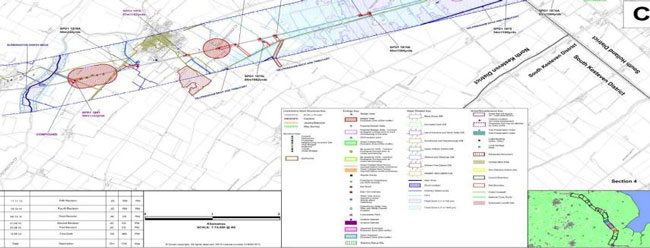
High Level Environmental Constraints Map
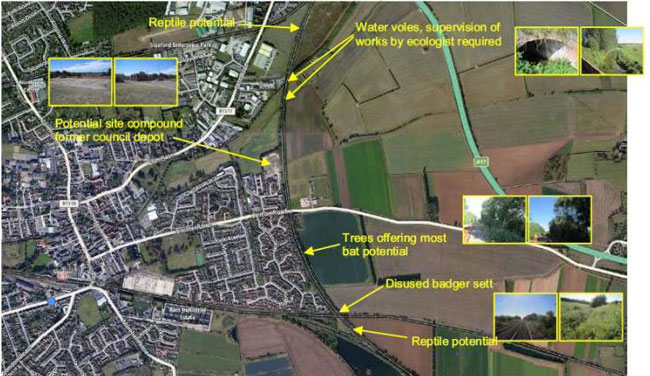
Detailed Area Specific Environmental Constraints Map - Mitigation Plan
- Environmental Hotspots Table – Whilst the Environmental Constraints Maps provided an extremely useful overview, it was felt at times (e.g. site visits/meetings), too unwieldy to be act as a “quick reference tool”. Therefore the GNGE Environment Team developed a Summary Table known as the GNGE Environmental Hot Spots Table. This quickly became an extremely useful tool for the GNGE Project Managers and Environmental Management Team as it could be brought to meetings and was also included in the GNGE Induction. This Table was updated every period as new or additional constraints became known.
- Pre-Section 61 Noise Assessment Tool – To gain a Consent for works that are likely to be noisy (known as a Section 61 Consent) can be time consuming and expensive. The GNGE Alliance Environment Team developed an industry first Noise Nuisance Assessment Screening Tool which allowed the Project to review likely noise levels from works and carry out a quick, desk-based assessment. This Assessment would then flag up which works are likely to trigger local noise disturbances and could then be used to tailor the works, to reduce work at more disturbing times (i.e. night/weekends) and/or apply for a S61 consent, saving months from the programme and preventing the risk of the Project being stopped/prosecuted.
Visual Amenity Impact Assessments
By bringing back into use a section of Line at Sleaford that had been mothballed for many years, the GNGE Alliance commissioned a Visual Amenity Impact Assessment to demonstrate, from a variety of locations, what the line would look like before and during construction (when a number of trees would have to be removed) and provide a visual representation of how the line would look in 3 and 10 years. This was extremely useful in managing the concerns of local residents.

Views before and during construction

Views after 3 and 10 years
Construction Industry Recognised Best Practice Awards
In addition to the CEEQUAL Award we also set a target of achieving a Considerate Constructor Scheme score between 35 and 40. The GNGE Alliance actually achieved a Considerate Constructor Score of 43, achieving Excellent in 2 of the 5 Categories and Exceptional in the other 3.
To what extent did the use of CEEQUAL influence your project?
CEEQUAL played a huge role as the main driver for the delivery and implementation of the vast majority of the environmental and sustainable improvements initiated on the GNGE Alliance Project. The GNGE Alliance Environment Manager and Alliance Leadership Team set 14 stringent Environmental and Sustainable Targets and Objectives for the Project, with one of the key ones the achievement of a Good or Very Good Score for CEEQUAL. This targeted commitment helped to provide a focus to deliver many of our aims, goals and objectives.
If you would like any further information on the Project’s Environmental and Sustainable Initiatives please contact Paul
Panini on 0770 990 4201

